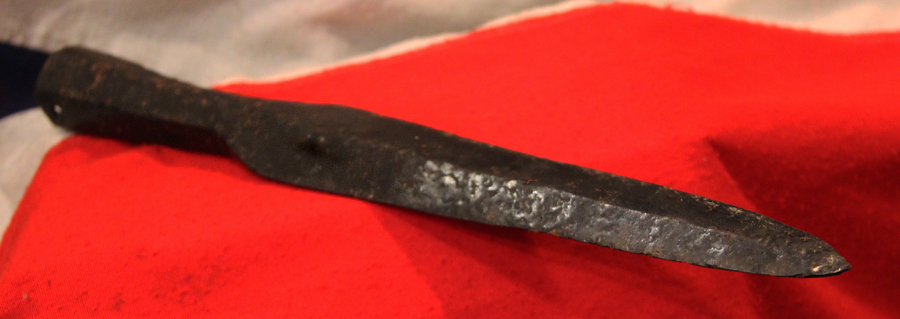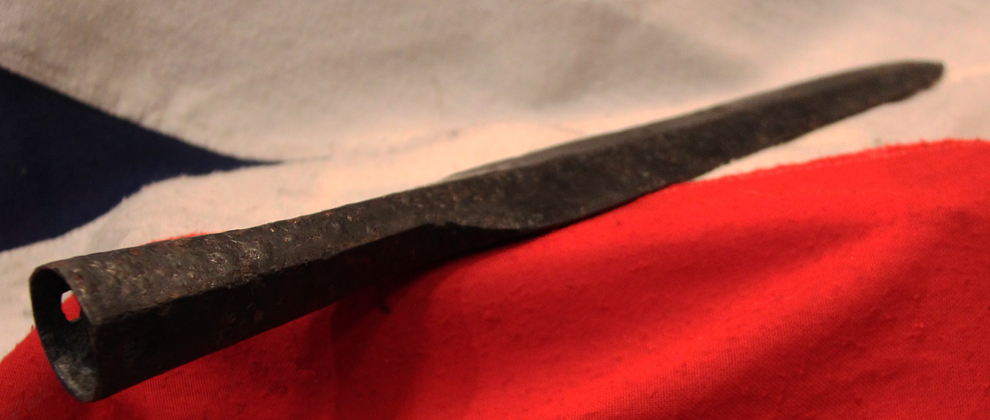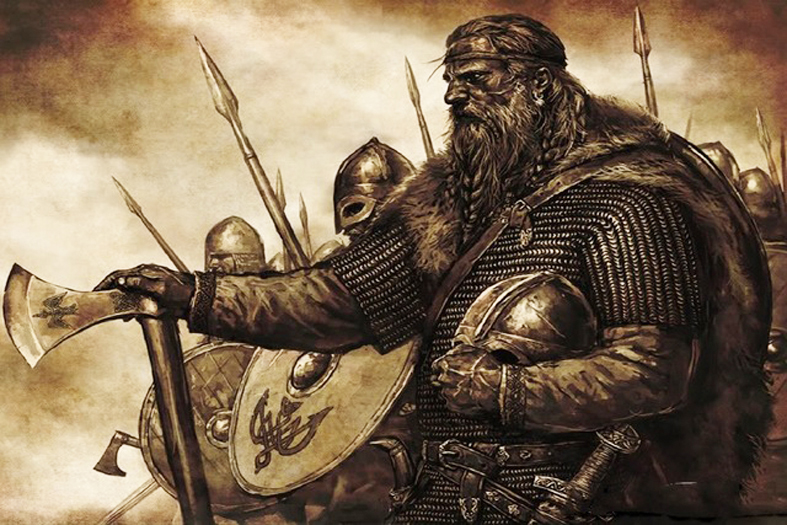A Very Powerful and Substantial Viking Chiefs Guard's Spear. Around 1200 Years Old. Used From The Time of The Seige of Paris on The Seine in 845, By Viking Chieftain Ragnar in Command of His 120 Longships
A heavy grade spear made between the 9th and 11th Centuries, very likely used by a senior man of a Viking chiefs guard. Thus around 1200 years old, from the peak of the era of the great seafaring Scandinavian Viking conquerers.
Between 1000 and 1200 years old, From the time of the Viking siege of Paris.
The siege of Paris of 845 was the culmination of a Viking invasion of West Francia. The Viking forces were led by a Norse chieftain named "Reginherus", or Ragnar, who tentatively has been identified with the legendary saga character Ragnar Lodbrok. Reginherus's fleet of 120 Viking ships, carrying thousands of warriors, entered the Seine in March and sailed up the river.
Ragnar's Vikings raided Rouen on their way up the Seine in 845 and in response to the invasion, determined not to let the royal Abbey of Saint-Denis (near Paris) be destroyed, Charles assembled an army which he divided into two parts, one for each side of the river. Ragnar attacked and defeated one of the divisions of the smaller Frankish army, took 111 of their men as prisoners and hanged them on an island on the Seine to honour the Norse god Odin, as well as to incite terror in the remaining Frankish forces.
The Vikings reached Paris at the end of the month, during Easter. They plundered and occupied the city, withdrawing after Charles the Bald paid a ransom of 7,000 French livres 2,570 kg (83,000 ozt) in gold and silver.
Ragnar's fleet made it back to his overlord, the Danish King Horik I, but Ragnar soon died from a violent illness that also spread in Denmark
With an octagonal form socket and two holes for affixing it to its haft with a square section rivet. Formerly the property of an English gentleman, from his collection orginally acquired from the 1940's. In chapter 55 of Laxdæla saga, Helgi had a spear with a blade one ell long (about 50cm, or 20in). He thrust the blade through Bolli's shield, and through Bolli. In chapter 8 of Króka-Refs saga, Refur made a spear for himself which could be used for cutting, thrusting, or hewing. Refur split Þorgils in two down to his shoulders with the spear. The spearheads were made of iron, and, like sword blades, were made using pattern welding techniques (described in the article on swords) during the early part of the Viking era . They could be decorated with inlays of precious metals or with scribed geometric patterns
After forming the head, the smith flattened and drew out material to form the socket . This material was formed around a mandrel and usually was welded to form a solid socket. In some cases, the overlapping portions were left unwelded. Spear heads were fixed to wooden shafts using a rivet. The sockets on the surviving spear heads suggest that the shafts were typically round, with a diameter of 2-3cm (about one inch).
However, there is little evidence that tells us the length of the shaft. The archaeological evidence is negligible, and the sagas are, for the most part, silent. Chapter 6 of Gísla saga tells of a spear so long-shafted that a man's outstretched arm could touch the rivet. The language used suggests that such a long shaft was uncommon.
Perhaps the best guess we can make is that the combined length of shaft and head of Viking age spears was 2 to 3m (7-10ft) long, although one can make arguments for the use of spears having both longer and shorter shafts. A strong, straight-grained wood such as ash was used. Many people think of the spear as a throwing weapon. One of the Norse myths tells the story of the first battle in the world, in which Oðin, the highest of the gods, threw a spear over the heads of the opposing combatants as a prelude to the fight. The sagas say that spears were also thrown in this manner when men, rather than gods, fought. At the battle at Geirvör described in chapter 44 of Eyrbyggja saga, the saga author says that Steinþórr threw a spear over the heads of Snorri goði and his men for good luck, according to the old custom. More commonly, the spear was used as a thrusting weapon. The sagas tell us thrusting was the most common attack in melees and one-on-one fighting, and this capability was used to advantage in mass battles. In a mass battle, men lined up, shoulder to shoulder, with shields overlapping. After all the preliminaries, which included rock throwing, name calling, the trading of insults, and shouting a war cry (æpa heróp), the two lines advanced towards each other. When the lines met, the battle was begun. Behind the wall of shields, each line was well protected. Once a line was broken, and one side could pass through the line of the other side, the battle broke down into armed melees between small groups of men.
Before either line broke, while the two lines were going at each other hammer and tongs, the spear offered some real advantages. A fighter in the second rank could use his spear to reach over the heads of his comrades in the first rank and attack the opposing line. Konungs skuggsjá (King’s Mirror), a 13th century Norwegian manual for men of the king, says that in the battle line, a spear is more effective than two swords. As with all our items it comes complete with our certificate of authenticity. 13.75 inches long.
Before either line broke, while the two lines were going at each other hammer and tongs, the spear offered some real advantages. A fighter in the second rank could use his spear to reach over the heads of his comrades in the first rank and attack the opposing line. Konungs skuggsj (King’s Mirror), a 13th century Norwegian manual for men of the king, says that in the battle line, a spear is more effective than two swords.
As with all our items it comes complete with our certificate of authenticity. 13.75 inches long.
Code: 22090









